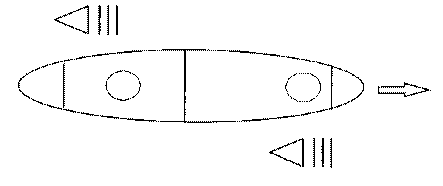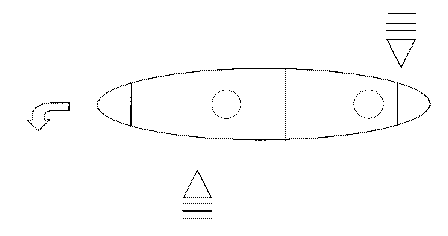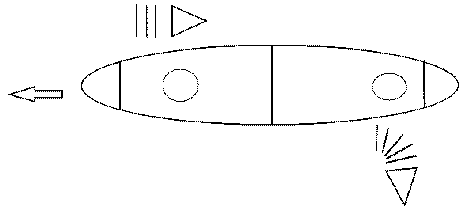|
|
Paddling Tips |
Entering Your Canoe |
||||||
| Before we discuss paddling the canoe, let's explore a major cause of wet paddlers: getting into the canoe. A canoe is designed to carry a load when supported totally by water. It is not a bridge. It is very vulnerable to capsizing and very unstable with one end on shore, the other end in the water and the mid-section unsupported. Put the canoe in the water parallel to the shore. Place one hand on the near gunwale and one foot in the center of the canoe. Crouch low and grab the far gunwale with the other hand as you transfer your weight to the foot in the canoe. Swing your other foot into the canoe and drop to your knees. Remain there while your partner boards, then assume your paddling positions. | ||||||
| Paddling Your Canoe | ||||||
| The basic theory of paddling a canoe is to place the paddle in the water and move the canoe toward it. With this in mind, we will describe the four most important and commonly used strokes. Keep the paddle as near vertical as possible. Your upper hand should be at eye level. Reach out with your lower hand as far as possible, arm fully extended. Dip the blade in the water and push with your upper hand. Don't continue the stroke beyond your body, as you'll waste effort. Keep it in front of you. The idea is to create a fulcrum with your arms. Remember, move the canoe toward the paddle. Slice the blade out of the water by dropping the top hand and feather the blade during the recovery. Switching sides is okay. It rests some muscles, while helping to maintain course. You can switch sides every 5-6 strokes to keep the canoe going straight without using a steering stroke. One paddler yells hut and you switch sides together. | ||||||
|
||||||
| Some Strokes to Practice | ||||||
Forward or Power Stroke To paddle on the left side, place your right hand on the grip. It controls the blade angle. Your left hand holds the shaft several inches above the blade. Keep this hand out of the water. Wet hands only cause blisters. (To paddle on the right, just reverse hands). |
 |
|||||
| Reverse or Back Stroke: This important stroke gives you time to decide which way to go, slow your approach to a standing wave, or to stop. Opposite of the power |  |
|||||
Draw Stroke: The draw is used for quick change of direction. The mechanics of the stroke are basically the same as the forward stroke, except that the draw stroke is perpendicular to the centerline. Lean out over the water as you begin your stroke. The water from the blade pushes against the side of the canoe and tends to tilt the canoe away from the stroke. Don't let the paddle get swept under the canoe. |
 |
|||||
'J' Stroke: To keep a canoe on course, the stern paddler must make some adjustments to his stroke. The most common way is by using the traditional 'J' stroke. Flip the paddle out at the end of a forward stroke and either push out or rudder to maintain a straight course. |
 |
|||||
| Now that you have read about it, take your canoe out on a lake or calm
stretch of river and practice paddling straight. When that stroke is mastered,
work on the others. Since most everyone will be paddling on a lake sooner or
later, it is worth discussing the effect that the wind has on the handling of
your canoe. Canoes are designed to paddle level, but if you're heading into
the wind, trim the canoe forward (bow heavy). This will allow the stern to
weathervane and align itself with the wind. The easiest way to do this,
assuming the canoe is in level trim, is for one or both paddlers to kneel in
front of their seats. In a following wind, do just the opposite.
If the waves pick up along with the wind, don't panic. It's very difficult to upset an empty canoe; people tip canoes over. Just lower your center of gravity by dropping to your knees and continue paddling. If you're still concerned, you can always sit on the bottom and paddle to shore. When encountering low overhanging limbs, always duck forward and not to the side. Remember to maintain a low center of gravity. Canoeing is a lot of fun, but take it one step at a time. Don't get in water beyond your capabilities and always wear a Coast Guard approved PFD. Join a canoe club if possible. Many of then offer various clinics. Check with your local YMCA or Red Cross chapter for classes. |
||||||
| Transporting Your Canoe | ||||||
| Unfortunately, since 1973, most American made cars no longer have substantial rain gutters. One solution is the foam car-top carrier. Clip the pads on the gunwales and set the canoe on the roof of your car. Center the canoe on your roof and position it so that the ends are equidistant from the bumpers. Slide the pads to the front and back edge of the roof line for added strength. Make sure that there is adequate clearance between the roof of the car and the center thwart. Pad if necessary. Tie one end of a 3/16” piece of rope to a gutter clip, position it even with a foam pad,, toss the rope over the canoe and tie to a clip on the other side. Pull tight enough so that the roof just begins to dent. Do the same for the other two clips. Next, tie both bow and stern to the bumpers. The best way to do this is to take a long piece of 3/16” rope and tie the middle of it through one of the eyelets. Next tie the ends as far out on the bumper as possible, making sure that they won't slide and loosen the ropes. Now do the same with the other end. This 'V' arrangement resists crosswinds. If you have a car with rain gutters and don't want to use the foam pads, you have an alternative. Securely mount a well made, bar-type roof rack to your car. Place the canoe on the rack and position it as before. Using 3/16” rope, tie one end to the rack next to the gunwale of the canoe. Toss it over the canoe and tie next to the gunwale on the other side. Do the same on the other rack. Then tie both ends of the canoe to the bumper as before. After you have tied your canoe on the car, give it the shake test. If you can grab one end of the canoe and rock the car with it, then it should be secure. | ||||||
Send mail to johnbell@redtailpaddle.com with questions or comments about this web site. Copyright © 2015 Redtail Paddle Co. |